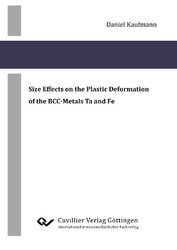| Fachbereiche | |
|---|---|
| Buchreihen (96) |
1379
|
| Nachhaltigkeit |
3
|
| Gesundheitswesen |
1
|
| Geisteswissenschaften |
2367
|
| Naturwissenschaften |
5407
|
| Ingenieurwissenschaften |
1793
|
| Allgemeine Ingenieurwissenschaften | 292 |
| Maschinenbau und Verfahrenstechnik | 862 |
| Elektrotechnik | 686 |
| Bergbau- und Hüttenwesen | 30 |
| Architektur und Bauwesen | 75 |
| Allgemein |
98
|
|
Leitlinien Unfallchirurgie
5. Auflage bestellen |
|
Erweiterte Suche
Size Effects on the Plastic Deformation of the BCC-Metals Ta and Fe
Daniel Kaufmann (Autor)Vorschau
Inhaltsverzeichnis, Datei (63 KB)
Leseprobe, Datei (240 KB)
Size effects can cause a significant increase in the strength of a metal. In the past, this effect has been extensively investigated for fcc metals but until today only limited knowledge exists on the size dependent behaviour of bcc metals. Bcc metals are used in many applications and, therefore, knowledge of their size scaling is of technological importance. Size effects in bcc metals are also interesting from a fundamental scientific point of view, since underlying dislocation processes of bcc metals differ from those of fcc metals. In contrast to fcc metals, where screw and edge dislocations have similar mobilities with little or no temperature dependence, the mobility of screw dislocations in bcc metals is strongly temperature dependent. In bcc metals, screw dislocations move by thermally activated kink pair nucleation and motion. Below the material dependent athermal temperature, their mobility is lower than that of edge dislocations. In this work, the deformation of Ta and -Fe micropillars was studied using microcompression experiments. Pillars were produced using a focused ion beam microscope and were compressed in a nanoindenter using a flattened tip. The experiments show that there is a distinct size effect in bcc metals. The size effect of -Fe is similar to the one found in typical fcc metals, and it is more pronounced than the one observed in Ta. A combination of this data with data obtained from fcc metals and from several other bcc metals indicates that the size dependence of bcc metals is temperature dependent. The differences in the mechanical behaviour between fcc and bcc metals can be attributed to the difference in mobility of screw dislocations in fcc and bcc metals. Results from microcompression experiments also indicate that screw dislocations control the deformation process. The results of these experiments can be explained by surface enhanced mobilities of screw dislocations. Overall, the mechanical behaviour of small bcc metals may be described by scaling laws as known from fcc metals and an additional temperature dependent component arising from the limited mobility of screw dislocations.
| ISBN-13 (Printausgabe) | 3869556544 |
| ISBN-13 (Printausgabe) | 9783869556543 |
| ISBN-13 (E-Book) | 9783736936546 |
| Buchendformat | A5 |
| Sprache | Englisch |
| Seitenanzahl | 156 |
| Umschlagkaschierung | matt |
| Auflage | 1 Aufl. |
| Band | 0 |
| Erscheinungsort | Göttingen |
| Promotionsort | Universität Karlsruhe |
| Erscheinungsdatum | 28.02.2011 |
| Allgemeine Einordnung | Dissertation |
| Fachbereiche |
Allgemeine Ingenieurwissenschaften
|
| Schlagwörter | Tantal, mechanischer Größeneffekt, kubischraumzentriert, Mikrodruckversuch, Schraubenversetzungen |








